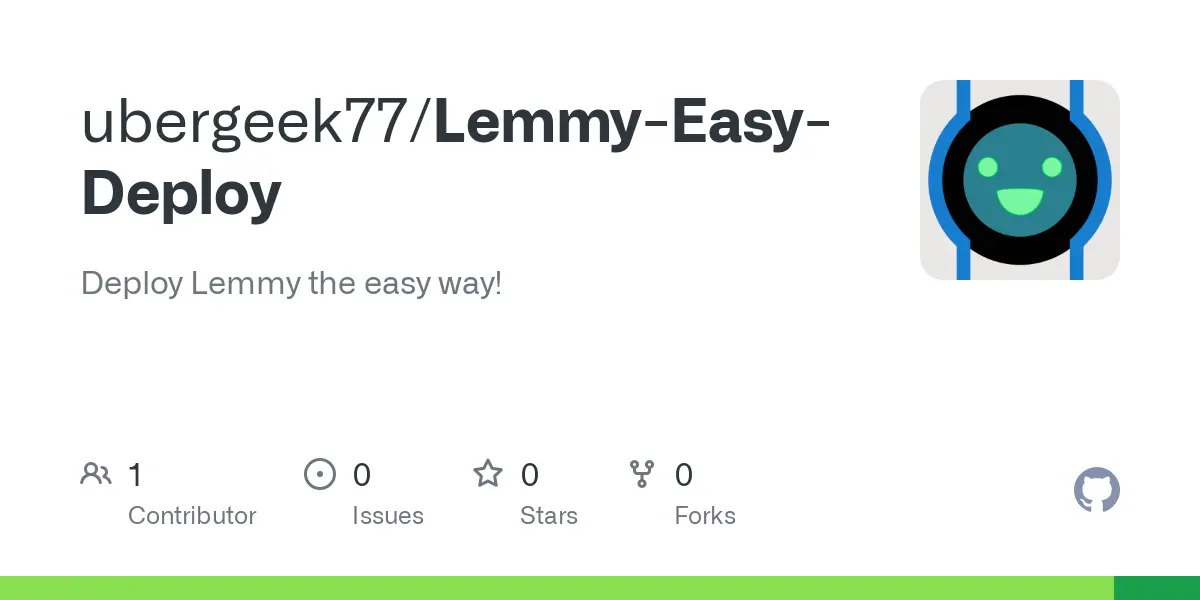Search
Slow self host build
Good morning y'all, so I have a server pc that I've been slowly adding bits and pieces to for about a year now. It started off as a barebones board with a nvme on it, and has slowly developed into a Plex box and game server host box.
This morning I just added an AIO. I've been hosting a Palworld server, and it's averaging 35% cpu usage and 27gb of ram. When the sever is on, the poor stock CPU fan is just running all the time. It's so much quieter now!
That's all, just wanted to share. Self Host has been super helpful with learning how to self host!
Lemmy EZ-Mode Docker-Compose Stack
EZ-Mode for Lemmy. Contribute to tgxn/lemmy-ezmode development by creating an account on GitHub.

I made this stack based on my own deployment of Lemmy, it should allow anyone to run a Lemmy stack in Compose, with LE SSL behind Traefik. I've tested it behind docker-compose on Windows and Ubuntu. Interested in any feedback or PRs :)
Seeking Lemmy Architects/Developers
I am the CTO for an early-stage FinTech startup, and am looking to connect with architect-level developers who have managed their own self-hosted instance of Lemmy to help stand up a standalone, non-federated instance on a cloud provider such as AWS or Azure. This would be paid work, can be part-time to fit your schedule, and will have the option to become full-time upon our next round of funding.
Please reply or DM me if you have any interest and would like more details. Thanks!
Jason
Reached a huge milestone in my selfhosted journey, all thanks to people in the community and duckduckgo searches
Just wanted to say thank you to everyone in the community for being awesome, this is not a help request just me being super happy that I have finally overcome one of the biggest challenges I set for myself with self-hosting, making a media server that I can add media to at any time from anywhere in the world so that my family and I, located on different continents, can immediately enjoy it!
My Raspberry Pi started out as just a simple Nextcloud box that I could access outside the home to escape from the Dropboxes and Google Drives of the world.
I ended up finding out everything that I can do with it and became more and more enthralled and tried to challenge myself. I learned so much about NFS, config files, iptables, and Linux/networking in general that I feel the knowledge itself was worth the struggle.
While I have more than a few programs on there, the most challenging thing has been this (which I just now put the final touches on accomplishing):
-
Have a Jellyfin server on the Pi which can be accessed from anywhere in the world.
-
Be able to add media to Jellyfin via torrent.
-
Used a separate (very old, Windows XP era) 32-bit computer only to be a torrent box (running latest Debian). I connect to my VPN provider via openvpn on the command line with transmission-daemon running behind that. However, I want to be able to add a torrent from anywhere in the world at any time and I cannot do that if transmission-daemon is hiding behind a VPN. Therefore I need to be able to create an ssh tunnel, but I can't do that if the entire server is behind a VPN! Therefore I had to learn to mess with iptables and ip rules, but I was able to make SSH use the default network while everything else uses the VPN, and so now I can ssh tunnel from outside the home network and open transmission in a browser that way.
-
Since I am using two separate machines (the torrent box for downloading torrents and the Raspberry Pi for hosting the media server), I created an NFS share on the Raspberry Pi where the media would sit and mounted it on the torrent box, having all finished media files be placed in there.
-
I set up Jellyfin to refresh every 6 hours to update the media that I now have.
If anybody here is trying to do this and is having issues, I'm happy to answer any questions!
Having trouble deploying Lemmy? Try my new script! Get up and running in minutes!
Deploy Lemmy the easy way! Contribute to ubergeek77/Lemmy-Easy-Deploy development by creating an account on GitHub.

In the past few days, I've seen a number of people having trouble getting Lemmy set up on their own servers. That motivated me to create Lemmy-Easy-Deploy, a dead-simple solution to deploying Lemmy using Docker Compose under the hood.
To accommodate people new to Docker or self hosting, I've made it as simple as I possibly could. Edit the config file to specify your domain, then run the script. That's it! No manual configuration is needed. Your self hosted Lemmy instance will be up and running in about a minute or less. Everything is taken care of for you. Random passwords are created for Lemmy's microservices, and HTTPS is handled automatically by Caddy.
Updates are automatic too! Run the script again to detect and deploy updates to Lemmy automatically.
If you are an advanced user, plenty of config options are available. You can set this to compile Lemmy from source if you want, which is useful for trying out Release Candidate versions. You can also specify a Cloudflare API token, and if you do, HTTPS certificates will use the DNS challenge instead. This is helpful for Cloudflare proxy users, who can have issues with HTTPS certificates sometimes.
Try it out and let me know what you think!
https://github.com/ubergeek77/Lemmy-Easy-Deploy
Nextcloud Hub 5
📢 Introducing Hub 5: Self-hosted AI-powered digital workspace for everyone! ✨ AI that respects privacy 💬 Call transcripts, translation & dictation 🗂️ Automated file locking on desktop 🪟 Outlook, Exchange & Teams integration 🚀 Notes, Tables app & more! https://nextcloud.com/blog/introducing-...
cross-posted from: https://lemmy.ml/post/1235039
> https://nextcloud.com/blog/introducing-hub-5-first-to-deliver-self-hosted-ai-powered-digital-workspace/
Reminder for this community!
Lemmy doesn’t have flags yet, so mark it with [Question], [Help], [Project], [Other], [Promoting] or other you may think is appropriate.
